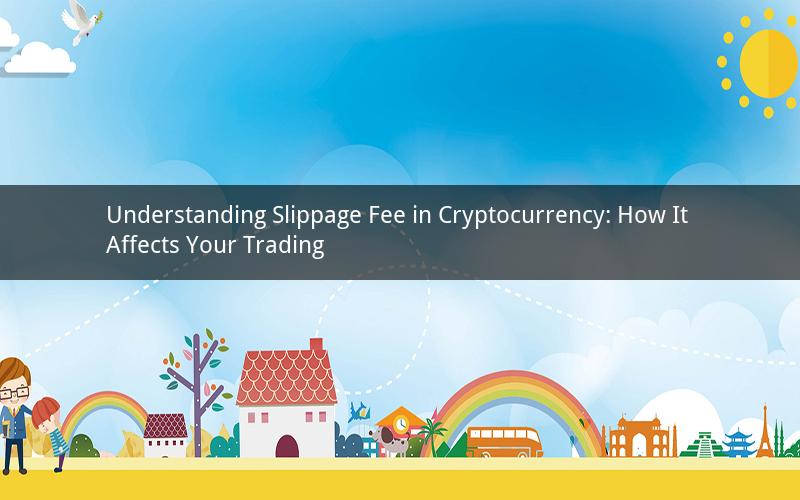
Introduction:
Cryptocurrency trading has become increasingly popular over the years, offering investors a wide range of opportunities. However, it is essential to understand the various aspects of trading to make informed decisions. One crucial element is the slippage fee, which can significantly impact your profits and losses. In this article, we will delve into what slippage fee is in cryptocurrency and its implications.
What is Slippage Fee in Cryptocurrency?
Slippage fee refers to the difference between the expected price at which a trade is executed and the actual price at which it is executed. It occurs when there is a sudden movement in the market price, causing the executed price to be different from the expected price. This discrepancy is usually a result of high volatility in the cryptocurrency market.
The slippage fee is typically calculated as a percentage of the trade value and can vary depending on the trading platform and market conditions. While slippage is common in all financial markets, it is more prevalent in the cryptocurrency market due to its high volatility.
How Does Slippage Fee Affect Your Trading?
1. Impact on Profits and Losses:
The primary impact of slippage fee is on profits and losses. If the executed price is lower than the expected price, you will experience a loss due to slippage. Conversely, if the executed price is higher, you may gain more than expected. This uncertainty can be detrimental to your trading strategy and profitability.
2. Limiting Your Profits:
Slippage can limit your profits, especially when trading volatile cryptocurrencies. Suppose you have set a take-profit level, but the market price rapidly moves against you before the trade is executed. In that case, you may end up with a smaller profit or even a loss.
3. Increasing Transaction Costs:
Slippage fee adds to the overall transaction costs of trading cryptocurrencies. These additional costs can eat into your profits and make it more challenging to achieve a positive return on investment.
Factors Influencing Slippage Fee:
1. Market Volatility:
High market volatility can lead to increased slippage fee. When prices fluctuate rapidly, it becomes more challenging for traders to execute their trades at the desired price.
2. Order Type:
The order type you choose can affect the slippage fee. Market orders are more prone to slippage as they are executed at the best available price. On the other hand, limit orders allow you to specify the exact price at which you want to buy or sell, reducing the risk of slippage.
3. Trading Platform:
Different trading platforms have varying slippage fee structures. It is crucial to research and choose a platform that offers competitive fees and reliable execution.
Reducing Slippage Fee:
1. Use Limit Orders:
Instead of using market orders, opt for limit orders when trading cryptocurrencies. This approach allows you to set the exact price at which you want to buy or sell, reducing the risk of slippage.
2. Trade during Low Volatility Periods:
Attempt to execute trades during periods of low market volatility, as this can help minimize slippage fee.
3. Choose a Reputable Trading Platform:
Select a reliable trading platform with competitive fees and good liquidity. This will ensure better execution of trades and reduce the chances of slippage.
5 Questions and Answers:
1. Question: Can slippage fee be completely eliminated in cryptocurrency trading?
Answer: While it is impossible to eliminate slippage fee entirely, you can minimize its impact by employing strategies such as using limit orders and trading during low volatility periods.
2. Question: Does the slippage fee affect all types of cryptocurrency trading?
Answer: Yes, slippage fee can affect all types of cryptocurrency trading, but its impact may vary depending on the market volatility and trading platform.
3. Question: Is slippage fee the same as transaction fee?
Answer: No, slippage fee is not the same as transaction fee. While slippage fee is a result of market price movement, transaction fee is a fixed charge imposed by the trading platform for executing trades.
4. Question: Can slippage fee be positive?
Answer: Typically, slippage fee is negative, as it represents a discrepancy between the expected and executed price. However, in some rare cases, slippage fee can be positive when the executed price is higher than the expected price.
5. Question: What is the difference between slippage fee and slippage?
Answer: Slippage fee is the cost associated with slippage, while slippage refers to the difference between the expected and executed price.
Conclusion:
Understanding slippage fee is crucial for successful cryptocurrency trading. By being aware of its implications and employing strategies to minimize its impact, you can enhance your trading experience and maximize your profits. Remember to choose a reputable trading platform, use limit orders, and trade during low volatility periods to reduce slippage fee.